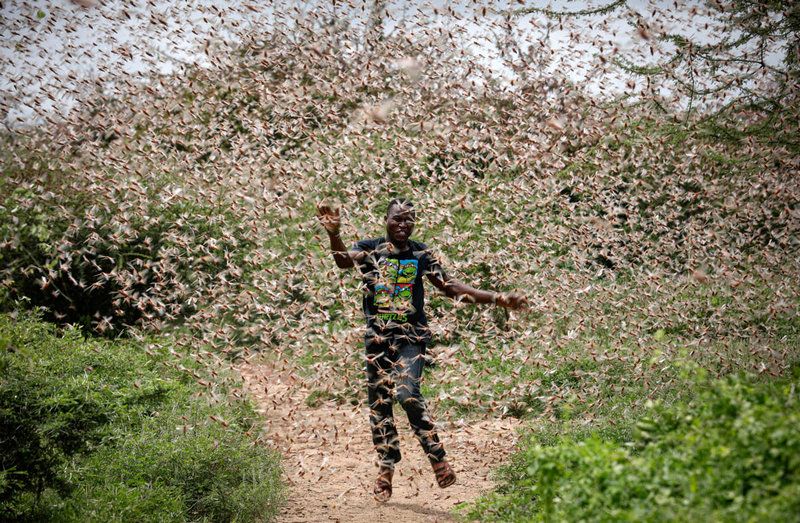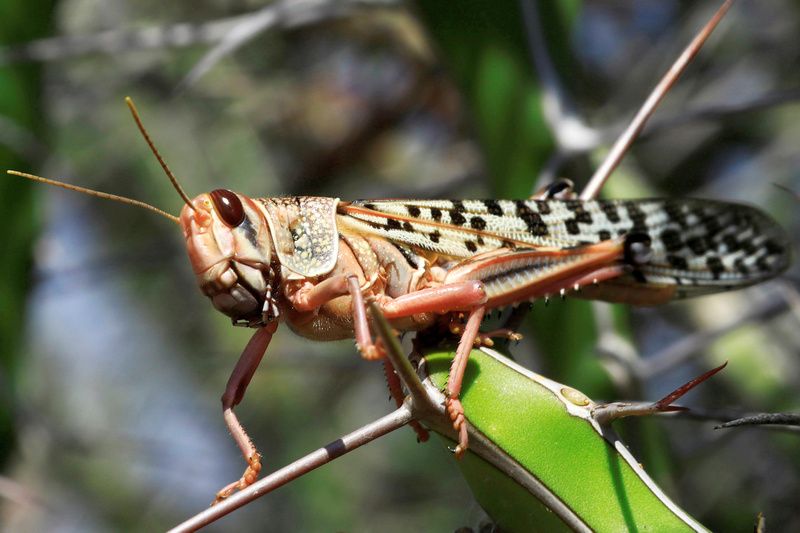Locust crisis poses a danger to millions

Kaamil Ahmed - Fri 20 Mar 2020 07.00 GMT
Experts fear swarms like those seen in Africa will become more common as tropical storms create favourable breeding conditions
The locust crisis that has now reached 10 countries could carry on to endanger millions more people, forecasters have said.
Climate change created unprecedented conditions for the locusts to breed in the usually barren desert of the Arabian gulf, according to experts, and the insects were then able to spread through Yemen, where civil war has devastated the ability to control locust populations.
It was Cyclone Mekunu, which struck in 2018, that allowed several generations of desert locusts the moist sand and vegetation to thrive in the desert between Saudi Arabia, Yemen and Oman known as the Empty Quarter, breeding and forming into crop-devouring swarms, said Keith Cressman, locust forecasting expert for the UN’s Food and Agriculture Organization (FAO).Advertisement
“That’s fine, that’s quite good in itself, but just about when those conditions are drying out and the breeding is coming to an end, a second cyclone came to the area,” he said.
“That allowed the conditions to continue to be favourable and another generation of breeding, so instead of increasing 400-fold, they increased 8,000-fold.
“Usually a cyclone brings favourable conditions for about six months and then the habitat dries out, and so it’s not favourable for reproduction and they die and migrate.”
The amount of cyclones in the area seem to be increasing, said Cressman, making it likely that locust swarms will also become more common.
The FAO has warned that the food security of 25 million people could be endangered by the locusts, which according to the agency’s locust monitoring service have been spotted in at least 10 countries over recent months. One swarm recently reported in Kenya covered an area the size of Luxembourg.
The organisation has requested $140m (£120m) to help fight the ongoing breeding of the insects, predicting that a continuation through late March and April could see the existing number of locusts grow by 400 times by June.
The current crisis is considered the worst in decades, and there are fears it could last longer than previous locust outbreaks.
Alongside the climate emergency impact, the war in Yemen is a key factor.
Cressman said Yemen is a “frontline” country for locusts, with the insects typically present throughout the year. But its once effective locust programme no longer has the same impact in cities where control is now divided between the government and Houthi rebels.
The head of the locust programme, Adel al-Shaibani, is based in the Houthi-controlled capital, Sana’a.
“Before the war we had a good ability to reach anywhere in Yemen,” he said. “In current times we’re just able to cover the Red Sea coastal areas – but not all – and some areas in the interior.”
He explained that there were two separate locust control centres in Yemen but neither was able to combat the outbreak effectively alone.
The Sana’a-based centre carried out control operations wherever they could in 2018, but they have been underfunded and have lost some of their vehicles.
“In spite of all our hard efforts, some areas remained out of control due to security reasons near the border with Saudi Arabia. The desert locust outbreak occurred and some swarms formed and moved to other areas,” said Shaibani.

By late 2019, the locusts had moved into the Horn of Africa, finding favourable conditions when an unseasonaal cyclone hit Somalia in December. This extended breeding time and allowed them to spread to areas authorities could not control because of the country’s security problems.
“This crisis could be quite long because of the Yemeni and Somali areas that cannot control the populations,” said Cyril Piou, an expert with the French Agricultural Research Centre for International Development.Advertisement
He said that in previous decades locust outbreaks had only lasted roughly two years but, without preventive systems, they will last longer, happen more frequently and spread further.
“We are all linked in some way, what is happening somewhere else affects us all,” he said.

Scientists turn to tech to prevent second wave of locusts in east Africa Read more
The last comparable locust outbreak was in the late 1940s and 50s, but Cressman said that was in a time when monitoring and reporting was a slow, cumbersome process and chemical pesticides were readily available for control operations.
Historically, the Arabian Gulf has very few cyclones. But the past decade has brought a significant increase thanks to the Indian Ocean dipole, a phenomenon linked to flooding in the western Indian Ocean, dry weather in the east and wildfires in Australia.
Cressman, part of whose job involves looking at historical conditions to understand current developments, said the climate’s behavioural changes made that difficult.
“This analogous forecasting methodology used to work pretty good up until five years ago, and it’s just not working very well any more at all because of the rainfall, the timing, the distribution. It’s very different,” he said.
WHO and WHAT is behind it all ? : >
The bottom line is for the people to regain their original, moral principles, which have intentionally been watered out over the past generations by our press, TV, and other media owned by the Illuminati/Bilderberger Group, corrupting our morals by making misbehavior acceptable to our society. Only in this way shall we conquer this oncoming wave of evil.
Commentary:
Administrator
HUMAN SYNTHESIS
All articles contained in Human-Synthesis are freely available and collected from the Internet. The interpretation of the contents is left to the readers and do not necessarily represent the views of the Administrator. Disclaimer: The contents of this article are of sole responsibility of the author(s). Human-Synthesis will not be responsible for any inaccurate or incorrect statement in this article. Human-Synthesis grants permission to cross-post original Human-Synthesis articles on community internet sites as long as the text & title are not modified.
The source and the author's copyright must be displayed. For publication of Human-Synthesis articles in print or other forms including commercial internet sites. Human-Synthesis contains copyrighted material the use of which has not always been specifically authorized by the copyright owner. We are making such material available to our readers under the provisions of "fair use" in an effort to advance a better understanding of political, economic and social issues. The material on this site is distributed without profit to those who have expressed a prior interest in receiving it for research and educational purposes. If you wish to use copyrighted material for purposes other than "fair use" you must request permission from the copyright owner.